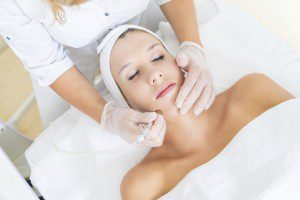Microdermabrasion
-
Content written by Andrew Proulx, MD | Reviewed by EnhanceMyself Medical Team | Last updated 6/18/2023
- Overview
Overview
What is microdermabrasion?
Microdermabrasion is a skin-enhancing procedure that uses epidermal resurfacing to treat a variety of skin issues, such as acne scarring and sunspots. As opposed to surgery or chemical peels, which are more invasive and require more recovery time, microdermabrasion is relatively conservative and requires virtually no downtime. Patients can even return to work right after having the treatment, which is why it has been nicknamed by some as “the lunchtime peel.”
Cost of microdermabrasion
A typical cost of microdermabrasion is anywhere from $75 to $200, with the average session costing $167 according to the American Society of Plastic Surgeons (ASPS). Depending on the treatment setting, you may receive a discount if you purchase a bundle of sessions.
There are essentially two primary types of microdermabrasion: crystal and diamond.
- Crystal Microdermabrasion: This is the more traditional approach, involving the use of tiny crystals to exfoliate the skin. On average, a single session of crystal microdermabrasion can cost anywhere from $75 to $200.
- Diamond Tip Microdermabrasion: Diamond tip microdermabrasion, on the other hand, utilizes a wand with a diamond-tipped head for exfoliation. It’s often seen as a neater option compared to crystal microdermabrasion. The cost per session typically falls in the range of $100 to $250.
Why patients choose this treatment
There are seemingly infinite options these days when it comes to skin treatments, and they can run a fortune. When in need of a quick, effective, and minimally invasive option to get dewy, soft, bright skin, this treatment option may be a great choice, and here’s why:
- Less time and discomfort
- No downtime or recovery
- Least invasive of facial treatments
- Safe and effective for all skin types
- Better than chemical peels and laser resurfacing for chest, neck, knees, elbows, etc.
What does it get rid of?

- Fine lines
- Sun damage
- Age spots
- Mild acne scarring
- Black/white heads
- Oily skin or dry/patching skin
- Stretch marks
- Hyper-pigmentation
Is it right for you?
The best candidates are healthy adults of any skin color with minor skin imperfections, like acne scarring or sun damage. It is important to have realistic expectations when considering this treatment, as some conditions require more aggressive approaches. Results are best when the patient follows the treatment plan of the health care provider. The best types of doctors to administer this treatment are dermatologists, plastic surgeons, or facial plastic surgeons.
Who is not a good candidate?
This treatment is not recommended for people with active skin infections or breakouts, such as acne (stage 3 and 4), open lesions, or herpes. Other contraindications include skin cancer, warts, sunburns, rosacea and eczema. People with uncontrolled diabetes, auto-immune disorders, and pregnant women should avoid microdermabrasion. When deeper scars, keloid scars, or deep wrinkles are present, a stronger treatment, such as a chemical peel or laser resurfacing, may be recommended.
How does it work?
A trained medical doctor, nurse, medical assistant, or aesthetician performs the procedure in an outpatient setting, such as a medical clinic or spa. The entire procedure takes anywhere from 30-60 minutes to complete.
During the procedure, tiny crystals on the end of a hand-held vacuum are used as an abrasive on the skin to gently remove the top layer of skin, called the stratum corneum.
As the skin heals, a new, fresh layer forms, revealing improved tone and texture. Although only the top layer is exfoliated, studies show that microdermabrasion affects the deeper layers of skin as well by rearranging skin pigment cells, improving wound healing, and increasing collagen density.
Does it hurt?
Most people have minimal discomfort with microdermabrasion. The sensation has been described as scratchy and warm, like a cat licking your face.
Safety information
There are few side effects associated with microdermabrasion. Occasionally, people will experience temporary redness and bruising. In addition, they may feel like their skin has been exposed to sun or wind.
The provider will usually recommend applying a moisturizer to the face immediately following the treatment and avoiding makeup application for the remainder of the day. This allows for the skin to breathe after the treatment and begin a healthy regeneration process.
How many treatments will you need?
Health care providers typically recommend 5 to 8 treatments spaced about one week apart. More sessions may be required for scars or sunspots. After the initial treatments, maintenance sessions are recommended every 2 to 3 months, when the skin has had time to regenerate through a few cycles.
How long will your results last?
Results are temporary, and regular treatments are recommended for maintaining even skin tone and texture.
Alternatives to microdermabrasion
When deeper scarring or more intense discoloration is present, microdermabrasion may not be a strong enough treatment. In these cases, there are a few alternatives, such as:
- Chemical Peels: Chemical peels exfoliate deeper layers of skin, and therefore can clear up deeper skin imperfections. There are multiple strength options of chemical peels, including light, moderate, and deep. Your clinician will be able to direct you on which one is most appropriate for your skin type. Unlike microdermabrasion, these treatments typically cause extreme redness and discomfort, and they require up to a week at home to recover after the procedure
- Laser Resurfacing: This method uses lasers to treat more serious skin conditions, such as deep wrinkles, spots, and wounds. Like chemical peels, these treatments are more effective for some skin conditions, but they also require downtime following the procedure
- Dermabrasion: This involves using a rotating brush to obtain a deeper resurfacing of the skin than is provided by microdremabrasion. The effects are more pronounced, but ore downtime is required
- Dermal fillers: These are injectable gels that are designed to reduce facial contour issues such as scarring, wrinkles, and loose skin by plumping up the underlying tissues so as to lift up the skin. More than one injection session may be required, and effects last on average 6-12 months, depending on the product used. Some popular dermal fillers include Juvederm, Radiesse and Restylane injections.
- Botulinum toxin: This is an injectable neurotoxin that is used to reduce fine lines and wrinkles by relaxing the underlying muscles. Effects are temporary, lasting 3-4 months. Popular brands include Botox Cosmetic, Dysport and Xeomin injections.
- Topical creams: There are a variety of topical treatments available for treating skin discoloration, lines and wrinkles, or loose skin. Some are available over the counter, while some are only available through prescription. They are generally used for mild skin concerns.
- Face-lift surgery: Face lift surgery is the ultimate treatment for lines, wrinkles, and loose skin. It is more invasive, but the effects are longer lasting, usually up to 10 years.
To learn more about microdermabrasion, visit the American Academy of Dermatology Association website.
EnhanceMyself.com relies on sources such as professional medical organizations, government agencies, academic institutions, and peer-reviewed scientific journals to write it’s articles. Learn more about how we ensure our content is accurate, in-depth, and unbiased by reading our editorial guidelines.
*Medical Disclaimer: This website does not provide medical advice. Read more.

